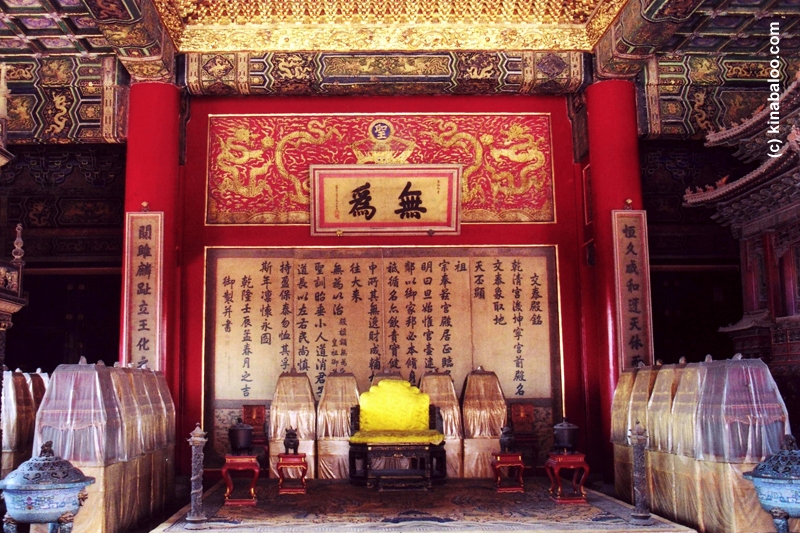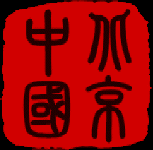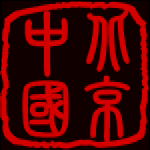The
Hall of Celestial and Terrestrial Union
交泰殿
The Hall of Celestial and
Terrestrial Union (JiaoTaiDian), was first built in
1420 and rebuilt in 1655 and 1798. One significance of
the name is the desire that the emperor (celestial) and
the empress (terrestrial) have a good marriage. This hall
resembles the Hall of Complete Harmony
(ZhongHeDian) in shape and is its smaller twin. It is the
smallest of the three main palaces in the Inner Court.
Usually, empresses would receive formal
birthday greetings here. Empresses would also inspect
preparations before they went to preside over memorial
ceremonies for the Silkworm God and practise sericulture.
Emperor ShunZhi's order that eunuchs were to be banned
from attending to state affairs was made here.
To the right of the throne, visitors
will see an ancient chinese water pot clock - equivalent
to an hourglass - and to the left there is a chime clock.
These two timers were a reference to the Drum Tower and
Bell Tower.
The large chiming clock on the left
hand side was built in the Palace in 1798 during the
reign of Emperor QianLong and, miraculously, the clock
still works. The water clock on the right hand side was
built in 1745. It is one of China's most outstanding
inventions and dates back about 2,500 years. It wasn't
until the mechanical clock was introduced to China after
the reign of Emperor QianLong (1736-1795) that the use of
the water clock was abandoned.
交泰殿,始建于1420年,在1655和1798年两次重修。这个名字有一个特殊的意义,就是指皇帝(上天)和皇后(陆地)和谐的融合在一起,有一个好的姻缘。交泰殿在外形上是中和殿的小孪生兄弟它们有着一样的外形。它是内庭后三宫中最小的一个。
通常皇后会在这正式接受她的生日庆贺礼。每年由皇后主持的祀先蚕的大典之前,皇后也会在此查阅采桑用具。清世祖顺治皇帝所立“内宫不许干预政事”的铁牌曾立于此殿。
在宝座的右边,游客可以看到一个古老的中式水灌钟—像沙漏一样,左边是一个报时钟。这两个计时器关系到钟楼和鼓楼。
这个在左边的巨大报时钟是在1798年乾隆统治期间建造于此的,不可思意的是,它到现在为止仍然在正点走着。右边的水钟建于1745年。它是2500年前中国的一个伟大发明。直到在乾隆皇帝以后,机械钟被引进到中国后这个钟才停止了使用。

This hall also holds 25
imperial seals - because Emperor QianLong hoped that the
Qing dynasty would last 25 reigns to exceed the East Zhou
dynasty, the longest dynasty in China. However history
disappointed him, the Qing dynasty only lasted ten
reigns.
There is a white tablet at the far end
that bears two Chinese characters : 'Wu Wei' - literally,
'to refrain from action' or 'let it be'. This reflects
the philosophy of Taoism, a religion which is indigenous
to China. The Tao ('the way') taught that we should find
and follow our true self and tries to show the beauty of
action without effort / struggle.
Taoism is a philosophy that nicely
balances rule-based confucianism. However, it was often
misused by the feudal rulers as indicating that people
should accept their place and to discourage people from
taking any action that might disrupt the imperial status
quo.
这个大厅里也存放了25个玉玺,因为乾隆皇帝希望大清朝能持续25个统治,比中国统治时间最长的东周还要长。然而历史让他失望了,大清朝仅仅持续了十个统治。
在宝座后面的墙上有个牌匾上面写着“无为”两个字,是康熙皇帝的御笔。字面理解是“不要做”或“按原有的样子存在”,这反应了孔子道教的思想。道教教导我们要发现自我跟随自我,要顺其自然的展现真正的美,不要刻意的去追求改变。
道教是儒家思想的精华,是中国的一个哲学体系,人们都深受其观念的影响,然而它也大大的帮助的封建统治制度,让人们遵守并接受现有的地位,现在拥有的,不要企图反抗或破坏统治者的地位。
 Next
: The Hall of Terrestrial Tranquility Next
: The Hall of Terrestrial Tranquility
 Forbidden City Forbidden City
Introduction
|



